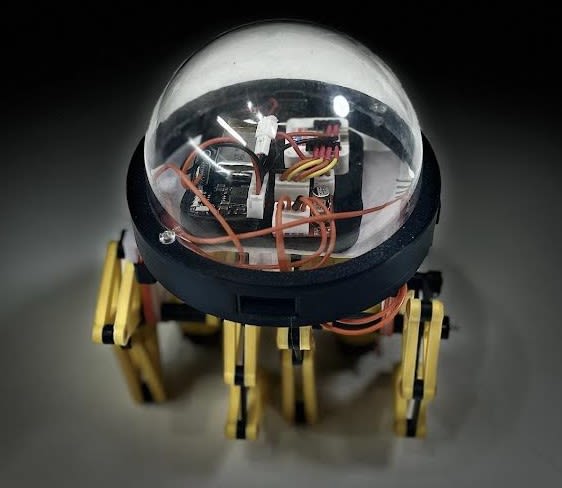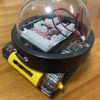 製作品
製作品  1907
1907【SPRESENSE2024】動くテオ・ヤンセン機構【eNord通信】
はじめに
今回は eNord を使ってロボットを動かします。
最低限の機構を搭載した eNord@Recvが spresense を使い eNord@Send で
自由に走行を行います。
eNord 簡単な解説
ロボットが大好きです
ロボット大好きですよ。ロボットを作る為にコンピュータをやっているといっても過言では無かったんですけど、いつの間にかセンサ屋さんになってた頃があります。あ、今は調理師やってますっ
ロボットの概念
あくまでも持論です
ロボットとは、単なる機械ではなく、人間の手を借りずに動作し、特定の目的を果たすために設計された「知的機構」です。その基本要素は大きく5つに分類され、それらが互いに密接に関わることで、真の「ロボット」として機能します。
-
CPU(制御装置)
ロボットの頭脳に相当する部分。現代のロボットは単純なリレー回路ではなく、マイクロコントローラやシングルボードコンピュータ、さらにはAIプロセッサを搭載することも珍しくありません。この中枢が全体の指令を出し、センサからの情報を解析し、適切なアクションを決定します。 -
センサ(知覚装置)
ロボットが環境を認識し、適応するための「目」「耳」「皮膚」に相当する部分。光学センサ、超音波センサ、ジャイロスコープ、加速度計、LiDARなど、多様なセンサが組み合わさり、ロボットの知覚能力を高めます。ロボットが知的に動作するためには、これらのデータを正しく処理し、状況に応じたフィードバックを行う必要があります。 -
移動手段(アクチュエータ)
ロボットが物理的に動作するための構造。移動ロボットであれば、車輪、脚、キャタピラなどが用いられ、マニピュレータや産業用ロボットであれば、多関節アームが該当します。動作の滑らかさや効率は、この機構の設計によって大きく左右されるため、機構設計の最適化はロボット開発において非常に重要です。 -
バッテリ(エネルギー源)
どれほど優れたCPUやアクチュエータを備えていても、電力がなければロボットは動きません。小型ロボットではリチウムイオンバッテリが主流ですが、大型機では燃料電池やエンジンを搭載することもあります。持続時間、充電速度、電力効率など、エネルギー管理もロボットの実用性を左右する重要な要素です。 -
カッコいい(ビジュアル)
見た目の美しさやデザインもロボットにとって重要な要素です。機能性だけでなく、魅力的な外観を持つことで、ユーザーの愛着や興味を引きつけます。映画やアニメに登場するロボットの多くは、単なる機械ではなく、デザインによって個性を持たせています。実際のロボット開発でも、工業デザインと機能性のバランスを考慮することが求められます。まぁカッコいいかどうかは個人の判断ではありますが。
この5つの要素が有機的に組み合わさることで、ロボットは単なる機械ではなく自律的に動作する知的存在となります。単純に上の5つの要素を組み上げただけではよいロボットにはなりません。
今回はテオ・ヤンセン機構
テオヤンセンではなくテオ・ヤンセンと記述するのが正しい
ではクローラや車輪から離れ、ちょい違った方向で攻めてみます。
オドメトリ(自己位置推定)とかが出来ない機構ではありますが、
そもそも自己位置推定実施には
- 車輪は床に密着し滑らない(タイヤの直径の3.14倍で必ず進む)
- タイヤは空回りしない(動けと命令を出したらその角度で動く)
- 積分で累積されるのでその誤差がどんどん溜まって行く
という問題点がありますのでそこを突っ込むのでは無く
カッコいいという1点に関して突き詰めて参ります
テオ・ヤンセン機構とは?
オランダの芸術家であり、工学者でもある テオ・ヤンセン(Theo Jansen)が考案した 独特なリンク機構 のことです。この機構は、風力で動く「ストランドビースト(Strandbeest)」と呼ばれる歩行機械の脚の動作を生み出します。
特徴
- 脚の動作がスムーズ: 一般的な二足歩行ロボットのようにジャンプせず、転倒しにくい歩行ができる。
- 車輪なしで移動可能: 自然な歩行運動に近い形で、風の力だけで前進できる。
- リンクの長さが数学的に最適化: ヤンセンは進化的アルゴリズムを使って、このリンク比率を求めた。
応用例
- 風で動く芸術作品(ストランドビースト)
- 省エネルギーな移動ロボット
- 不整地をスムーズに移動するロボットの脚機構
どう作る?
ホーリーナンバー
テオ・ヤンセン機構には
ホーリーナンバーと呼ばれる特殊な長さの組合せがあります
これをCADソフトの下書きとして使い作成する事は可能ですが
実はそれが大きな間違いだという事に実際に製作し分かりました。
これだけでは動かないのです
二年くらい研究を重ねました
結局の所、いかに重ね合わせ部分を少なくするかという事に落ち着きました。
Drone(どろーん) ≒ eNord(いーのぉど)
eNordはDroneのアナグラムです
spresense には通信機器が乗ってない
これは毎回毎回悩むんですけど無いんですよね。
で、今回も ESP32系のCPUを搭載する事にしました。
ESP32系のCPUを搭載すると特典があります
- 通信機能(BLE/WiFi/ESPNOW)が使える
- GROVE(一部で有名な通信ケーブル)が使える
- かなり安価(1000円)
ぢゃ双方にESP32使えば良いかも
動くロボット側と制御するspresense側の両方に搭載すれば良いかも!
motorSide
- ESPNOWを使って eNord で通信を受けます
- ESP32側の GPIO38/39 は I2C Master に使用し GPIO2/1 は XSHUT に使います。
| 部品名 | 販売先 | 価格 | 御提供品 |
|---|---|---|---|
| AtomS3Lite | M5Stack他 | $7.5 | - |
| モータドライバ(MX1508) | Amazon他 | 1,520円(@126円)(税込) | - |
| 壁センサ(VL5310)x3 | Alliexpress他 | 時価100..2,000円 | - |
| DCモータ(両サイドギア付)x2 | Alliexpress他 | 時価100..300円 | - |
spreSide
- ESP32側の GPIO2/1 は I2C に使い、spresenseからのI2C Slave として動作し eNord@Send を行います
- spresense 側拡張ボード I2C と接続を行います
| 部品名 | 販売先 | 価格 | 御提供品 |
|---|---|---|---|
| AtomS3Lite | M5Stack他 | $7.5 | - |
| SPRESENSEメインボード | Amazon他 | 6,080円(税込) | 〇 |
| SPRESENSE拡張ボード | Amazon他 | 4,500円(税込) | 〇 |
| 9軸 加速度計・ジャイロ・コンパスセンサ (BMI270・AK09918) Addon ボード | - | 〇 | |
| 4.0インチタッチパネル付き液晶(480x320) | Amazon他 | 2,861円(税込) | - |
| ジョイスティックモジュールx2 | Amazon他 | 149円(税込) | - |
制御は標準化したい
ESPNOWの仕様が変わったので最新にしてあります:2025/01/31時点
コード(ESP32共通部分)
esp32S3Lib.hpp
//
// esp32S3Lib.hpp
//
//
#include <Arduino.h>
//===========================
//
// Wire
//
//===========================
#include <Wire.h>
#ifndef GROVE
#define WIRE_SDA_PIN (38)
#define WIRE_SCL_PIN (39)
#else
#define WIRE_SDA_PIN ( 2)
#define WIRE_SCL_PIN ( 1)
#endif
#define WIRE_FREQ (400 * 1000)
#define WIRE_SLAVE_ADRS (0x4d)
#define WIRE_MASTER_ADRS (0x00)
#define WIRE_uSECDELAY (500)
enum {REG_STX = 0, REG_LEFT, REG_RIGHT, REG_WALL, REG_ETX};
#define WIRE_REGS_MAX (REG_ETX +1)
volatile uint8_t wireRegs[WIRE_REGS_MAX] = {0};
volatile uint8_t wireRegsPos = 0;
bool debugMode = false;
//===========================
//
// Wire
//
//===========================
//===========================
// wireScan
//===========================
void wireScan() {
int nDevices = 0;
for (byte address = 1; address < 127; ++address) {
Wire.beginTransmission(address);
byte error = Wire.endTransmission();
if (error == 0) {
Serial.print("I2C device found at address 0x");
if (address < 16) {
Serial.print("0");
}
Serial.print(address, HEX);
Serial.println(" !");
++nDevices;
} else if (error == 4) {
Serial.print("Unknown error at address 0x");
if (address < 16) {
Serial.print("0");
}
Serial.println(address, HEX);
}
}
if (nDevices == 0) {
Serial.println("No I2C devices found\n");
} else {
Serial.println("done\n");
}
}
//===========================
// onRequest
//===========================
void onRequest() {
Wire.write(wireRegs[wireRegsPos]);
delayMicroseconds(WIRE_uSECDELAY);
}
//===========================
// onReceive
//===========================
void onReceive(int len) {
if (Wire.available() >= 1) {
delayMicroseconds(WIRE_uSECDELAY);
wireRegsPos = Wire.read();
if (Wire.available() >= 1) {
delayMicroseconds(WIRE_uSECDELAY);
uint8_t data = Wire.read();
wireRegs[wireRegsPos] = data;
}
}
}
//===========================
// setupWire
//===========================
int setupWire(uint8_t slaveAdrs) {
int rtn = 0;
if (slaveAdrs) {
Wire.onReceive(onReceive);
Wire.onRequest(onRequest);
rtn = Wire.begin(slaveAdrs, WIRE_SDA_PIN, WIRE_SCL_PIN, WIRE_FREQ);
} else {
rtn = Wire.begin(WIRE_SDA_PIN, WIRE_SCL_PIN);
Wire.setClock(WIRE_FREQ);
wireScan();
}
return rtn;
}
//===========================
//
// espNow
//
//===========================
#include <esp_now.h>
#include <WiFi.h>
#define ESPNOW_uSECDELAY (500)
const uint8_t broadcastAddress[] = {0xFF, 0xFF, 0xFF, 0xFF, 0xFF, 0xFF};
//=========================
// onDataRecv
//=========================
void onDataRecv(const uint8_t *mac, const uint8_t *data, int len) {
if (len == sizeof(wireRegs)) {
memcpy((void*)wireRegs, data, sizeof(wireRegs));
}
}
//=========================
// onDataSent
//=========================
void onDataSent(const uint8_t *mac_addr, esp_now_send_status_t status) {
if (status == ESP_NOW_SEND_SUCCESS) {
if (debugMode) Serial.println("ESP-NOW: Data sent successfully!");
} else {
if (debugMode) Serial.println("ESP-NOW: Data send failed!");
}
}
//=========================
// sendData
//=========================
void sendData(uint32_t waitMsec) {
static uint32_t tm = millis();
if ((millis() - tm) > waitMsec) {
uint8_t temp[sizeof(wireRegs)];
tm = millis();
memcpy(temp, (const void*)wireRegs, sizeof(wireRegs));
esp_err_t result = esp_now_send(broadcastAddress, temp, sizeof(wireRegs));
delayMicroseconds(ESPNOW_uSECDELAY);
if (result == ESP_OK) {
if (debugMode) Serial.println("ESP-NOW: Data sent request successful.");
} else {
if (debugMode) Serial.printf("ESP-NOW: Failed to send data. Error code: %d\n", result);
}
}
}
//=========================
// setupEspNow
//=========================
void setupEspNow() {
WiFi.disconnect(true);
WiFi.mode(WIFI_STA);
if (esp_now_init() != ESP_OK) {
Serial.println("[ERROR] ESP-NOW Initialization Failed");
return;
}
if (esp_now_register_recv_cb(onDataRecv) != ESP_OK) {
Serial.println("[ERROR] Failed to Register Receive Callback");
return;
}
if (esp_now_register_send_cb(onDataSent) != ESP_OK) {
Serial.println("[ERROR] Failed to Register Send Callback");
return;
}
esp_now_peer_info_t peerInfo;
memset(&peerInfo, 0, sizeof(peerInfo));
memcpy(peerInfo.peer_addr, broadcastAddress, 6);
peerInfo.channel = 0;
peerInfo.encrypt = false;
if (esp_now_add_peer(&peerInfo) != ESP_OK) {
Serial.println("[ERROR] Failed to Add Peer");
return;
}
Serial.println("ESP-NOW Ready");
}
//===========================
//
// BtnA
//
//===========================
#define BTN_PIN (41)
int BtnA() {
static bool setupEd = false;
if (!setupEd) {
pinMode(BTN_PIN, INPUT_PULLUP);
setupEd = true;
}
static int stat_ = -1;
int stat = !digitalRead(BTN_PIN); // illogical
return stat;
}
//===========================
//
// IRLED
//
//===========================
#define IRLED_PIN ( 4)
void setupIrLed(uint8_t stat) {
static bool setupEd = false;
if (!setupEd) {
pinMode(IRLED_PIN, OUTPUT);
setupEd = true;
}
digitalWrite(IRLED_PIN, stat);
}
void setIrLed(int stat) {
digitalWrite(IRLED_PIN, stat);
}
//===========================
//
// NeoPixel
//
//===========================
#include <Adafruit_NeoPixel.h>
#define RGBLED_PIN (35)
#define NUM_LEDS ( 1)
#define DEFAULT_BRIGHTNESS (32)
typedef struct {
uint8_t r;
uint8_t g;
uint8_t b;
} COLOR_T;
Adafruit_NeoPixel neo(NUM_LEDS, RGBLED_PIN, NEO_GRB + NEO_KHZ800);
//===========================
// setupNeo
//===========================
void setupNeo(uint8_t brightness) {
static bool setupEd = false;
if (!setupEd) {
pinMode(RGBLED_PIN, OUTPUT);
setupEd = true;
}
neo.begin();
neo.setBrightness(brightness);
neo.show();
}
//===========================
// setNeo
//===========================
void setNeo(uint8_t r, uint8_t g, uint8_t b, uint16_t pixelIndex = 0) {
if (pixelIndex < NUM_LEDS) {
neo.setPixelColor(pixelIndex, neo.Color(r, g, b));
neo.show();
}
}
//===========================
// clearNeo
//===========================
void clearNeo() {
neo.clear();
neo.show();
}
//===========================
// blinkNeo
//===========================
void blinkNeo(uint32_t interval, uint8_t r, uint8_t g, uint8_t b) {
static uint32_t lastTime = 0;
static bool isOn = false;
if (millis() - lastTime > interval) {
lastTime = millis();
isOn = !isOn;
if (isOn) {
setNeo(r, g, b);
} else {
clearNeo();
}
}
}
//===========================
// breathNeo
//===========================
//#include <math.h>
void breathNeo(uint32_t interval, uint8_t baseR, uint8_t baseG, uint8_t baseB) {
static uint32_t lastTime = 0;
static float progress = 0.0;
if (millis() - lastTime > interval) {
lastTime = millis();
progress += 0.02;
if (progress > 1.0) progress -= 1.0;
float brightness = (sin(progress * 2 * PI) + 1.0) / 2.0;
uint8_t r = baseR * brightness;
uint8_t g = baseG * brightness;
uint8_t b = baseB * brightness;
setNeo(r, g, b);
}
}
//===========================
//
// dataDump
//
//===========================
void dataDump(uint8_t *data, int dataCnt) {
char msg[64] = {0};
Serial.println("dataDump");
for (int i = 0; i < dataCnt; i += 16) {
sprintf(msg, "%04X : ", i);
Serial.print(msg);
for (int j = 0; j < 16; j++) {
if (i + j < dataCnt) {
sprintf(msg, "%02X ", data[i + j]);
Serial.print(msg);
} else {
Serial.print(" ");
}
}
Serial.print(": ");
for (int j = 0; j < 16; j++) {
if (i + j < dataCnt) {
char c = data[i + j];
if (c >= 32 && c <= 126) {
Serial.print((char)c);
} else {
Serial.print(".");
}
}
}
Serial.println();
}
}
//===========================
//
// setupS3
//
//===========================
void setupS3(int wireMode, int bright, bool debugMode = false) {
Serial.begin( 115200 );
// while(!Serial);
delay( 1000 );
setupWire(wireMode);
setupNeo(bright);
setupIrLed(LOW);
setupEspNow();
Serial.println("esp32S3 Ready !");
}コード(SPRESENE Wireライブラリ)
spreWireLib.hpp
//
// spreWireLib.hpp
//
//
#include <Arduino.h>
//===========================
//
// Wire
//
//===========================
#include <Wire.h>
#define STX (0x02)
#define ETX (0x03)
#define WIRE_FREQ (400 * 1000)
#define WIRE_SLAVE_ADRS (0x4d)
#define WIRE_MASTER (0x00)
#define WIRE_uSECDELAY (500)
enum {REG_STX = 0, REG_LEFT, REG_RIGHT, REG_WALL, REG_ETX};
#define WIRE_REGS_MAX (REG_ETX +1)
volatile uint8_t wireRegs[WIRE_REGS_MAX] = {0};
volatile uint8_t wireRegsPos = 0;
bool debugMode = false;
//===========================
//
// Wire
//
//===========================
//===========================
// wireScan
//===========================
void wireScan() {
int nDevices = 0;
for (byte address = 1; address < 127; ++address) {
Wire.beginTransmission(address);
byte error = Wire.endTransmission();
if (error == 0) {
Serial.print("I2C device found at address 0x");
if (address < 16) {
Serial.print("0");
}
Serial.print(address, HEX);
Serial.println(" !");
++nDevices;
} else if (error == 4) {
Serial.print("Unknown error at address 0x");
if (address < 16) {
Serial.print("0");
}
Serial.println(address, HEX);
}
}
if (nDevices == 0) {
Serial.println("No I2C devices found\n");
} else {
Serial.println("done\n");
}
}
//===========================
// setupWire
//===========================
int setupWire() {
int rtn = 0;
Wire.begin();
Wire.setClock(WIRE_FREQ);
wireScan();
return rtn;
}
//===========================
//
// dataDump
//
//===========================
void dataDump(uint8_t *data, int dataCnt) {
char msg[64] = {0};
Serial.println("dataDump");
for (int i = 0; i < dataCnt; i += 16) {
sprintf(msg, "%04X : ", i);
Serial.print(msg);
for (int j = 0; j < 16; j++) {
if (i + j < dataCnt) {
sprintf(msg, "%02X ", data[i + j]);
Serial.print(msg);
} else {
Serial.print(" ");
}
}
Serial.print(": ");
for (int j = 0; j < 16; j++) {
if (i + j < dataCnt) {
char c = data[i + j];
if (c >= 32 && c <= 126) {
Serial.print((char)c);
} else {
Serial.print(".");
}
}
}
Serial.println();
}
}
//===========================
// wireWriteByte
//===========================
bool wireWriteByte(int adrs, uint8_t reg, uint8_t dt) {
Wire.beginTransmission(adrs);
Wire.write(reg);
Wire.write(dt);
uint8_t status = Wire.endTransmission();
if (status != 0) {
if (debugMode) Serial.printf("I2C Write Error: %d\n", status);
return false;
}
delayMicroseconds(WIRE_uSECDELAY);
return true;
}
//===========================
// wireReadByte
//===========================
uint8_t wireReadByte(int adrs, uint8_t reg) {
Wire.beginTransmission(adrs);
Wire.write(reg);
uint8_t status = Wire.endTransmission();
if (status != 0) {
Serial.printf("I2C Write Error: %d\n", status);
return 0xFF;
}
Wire.requestFrom(adrs, 1);
if (Wire.available()) {
delayMicroseconds(WIRE_uSECDELAY);
return Wire.read();
}
Serial.println("I2C Read Error: No data received");
return 0xFF;
}
//===========================
// wireToRegs
//===========================
void wireToRegs() {
wireRegs[REG_LEFT] = wireReadByte(WIRE_SLAVE_ADRS, REG_LEFT);
wireRegs[REG_RIGHT] = wireReadByte(WIRE_SLAVE_ADRS, REG_RIGHT);
wireRegs[REG_WALL] = wireReadByte(WIRE_SLAVE_ADRS, REG_WALL);
}
//===========================
// cpuToWire [OverLoad]
//===========================
void cpuToWire(int8_t stx, int8_t left, int8_t right, int8_t wall, int etx) {
// val => wireRegs
wireRegs[REG_STX] = stx;
wireRegs[REG_LEFT] = left;
wireRegs[REG_RIGHT] = right;
wireRegs[REG_WALL] = wall;
wireRegs[REG_ETX] = etx;
// wireRegs => wireWrite
wireWriteByte(WIRE_SLAVE_ADRS, REG_STX, wireRegs[REG_STX]);
wireWriteByte(WIRE_SLAVE_ADRS, REG_LEFT, wireRegs[REG_LEFT]);
wireWriteByte(WIRE_SLAVE_ADRS, REG_RIGHT, wireRegs[REG_RIGHT]);
wireWriteByte(WIRE_SLAVE_ADRS, REG_WALL, wireRegs[REG_WALL]);
wireWriteByte(WIRE_SLAVE_ADRS, REG_ETX, wireRegs[REG_ETX]);
wireToRegs();
}
void cpuToWire(int8_t left, int8_t right) {
// val => wireRegs
wireRegs[REG_LEFT] = left;
wireRegs[REG_RIGHT] = right;
// wireRegs => wireWrite
wireWriteByte(WIRE_SLAVE_ADRS, REG_LEFT, wireRegs[REG_LEFT]);
wireWriteByte(WIRE_SLAVE_ADRS, REG_RIGHT, wireRegs[REG_RIGHT]);
wireToRegs();
}
//===========================
//
// setupSpre
//
//===========================
void setupSpre(bool debufMode = false) {
Serial.begin( 115200 );
// while(!Serial);
delay( 1000 );
setupWire();
Serial.println("spreSense Ready !");
}コード(SPRESENSE本体)
spresense.ino
#include "spreWireLib.hpp"
//===========================
// setup
//===========================
void setup() {
setupSpre();
delay( 5000 );
cpuToWire(STX, 0, 0, 0, ETX);
}
//===========================
// loop
// 5v:7..993 3v3:7..656
//===========================
void loop() {
int16_t dt; // 0..32767
uint8_t left, right; // 0..255
dt = analogRead(A0);
left = right = map(dt, 7, 656, 0, 255);
cpuToWire(left, right);
dataDump((uint8_t *)wireRegs, sizeof(wireRegs));
}コード(VL53L0X用アドレス書込み)
c++multiSens.hpp
#ifndef __MULTISENS_HPP__ #define __MULTISENS_HPP__ //================================= // multiSens.hpp // //================================= #include <Wire.h> #include <VL53L0X.h> #define GPIO_DELAY (100) VL53L0X sens0; VL53L0X sens1; VL53L0X sens2; #define SENS_CNTMAX (3) #define SENS0_ENABLE_PIN (2) #define SENS1_ENABLE_PIN (1) #define SENS2_ENABLE_PIN (-1) int16_t sensVal[SENS_CNTMAX] = {0}; void i2cScan(TwoWire &wire, const char *msg) { Serial.printf("%s scan start ==>\n", msg); for (byte address = 1; address < 127; ++address) { wire.beginTransmission(address); if (wire.endTransmission() == 0) { Serial.printf("Found device at address: 0x%02X\n", address); } } Serial.printf("<== %s scan complete\n", msg); } void setupSensor(VL53L0X &sensor, int enablePin, uint8_t address) { if (enablePin > 0) { pinMode(enablePin, OUTPUT); digitalWrite(enablePin, LOW); digitalWrite(enablePin, HIGH); } sensor.init(); sensor.setAddress(address); sensor.startContinuous(); } void loopSensors() { sensVal[0] = sens0.readRangeContinuousMillimeters(); sensVal[1] = sens1.readRangeContinuousMillimeters(); sensVal[2] = sens2.readRangeContinuousMillimeters(); Serial.printf("%d,%d,%d\n", sensVal[0], sensVal[1], sensVal[2]); } void setupSensors() { setupSensor(sens2, SENS2_ENABLE_PIN, 0x31); setupSensor(sens1, SENS1_ENABLE_PIN, 0x30); setupSensor(sens0, SENS0_ENABLE_PIN, 0x29); } #endif
最後に
お疲れさまでございました
よりよい テオ・ヤンセンが出来ますように
投稿者の人気記事









-
chrmlinux03
さんが
2025/01/31
に
編集
をしました。
(メッセージ: 初版)
-
chrmlinux03
さんが
2025/01/31
に
編集
をしました。
(メッセージ: 終わった~)
ログインしてコメントを投稿する